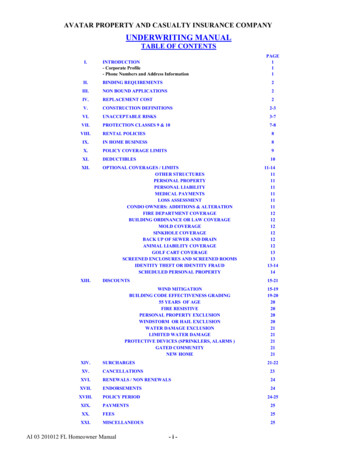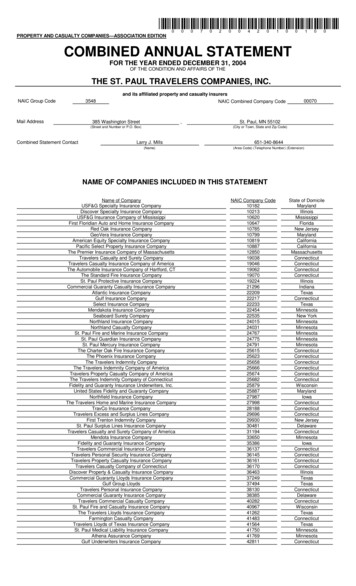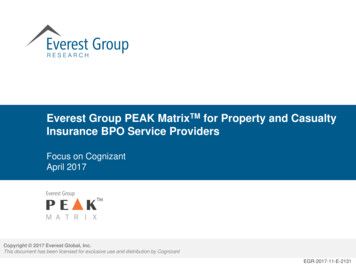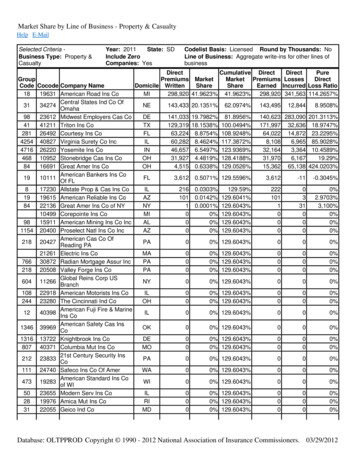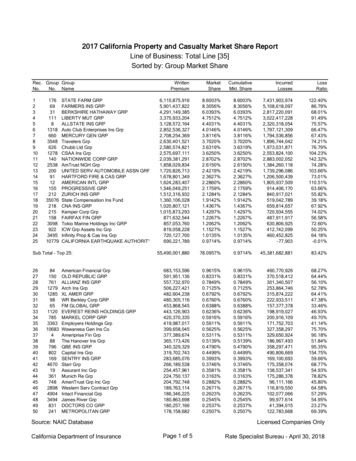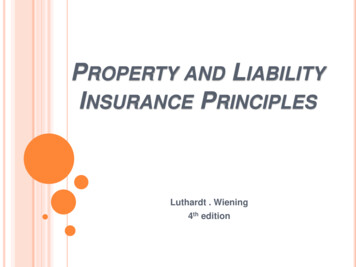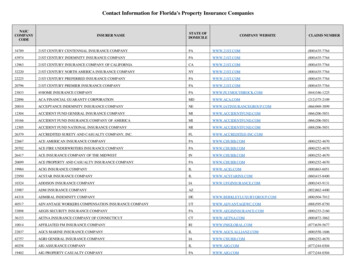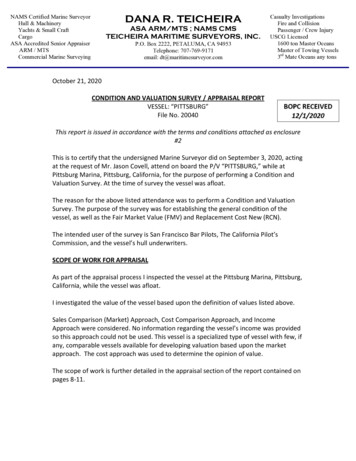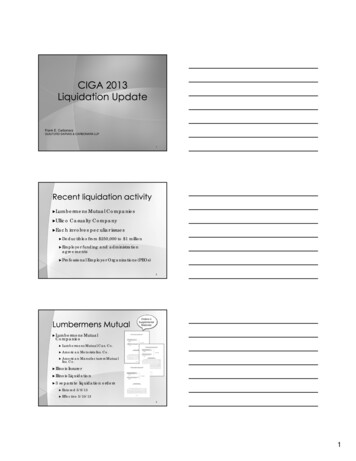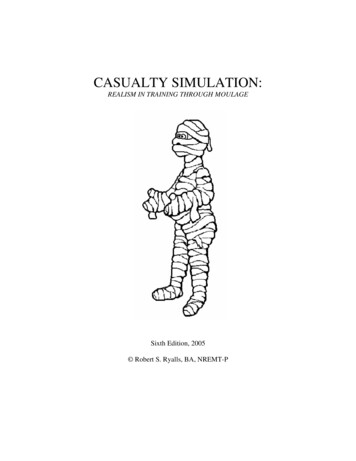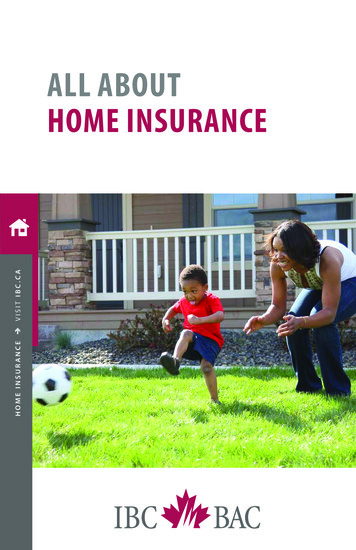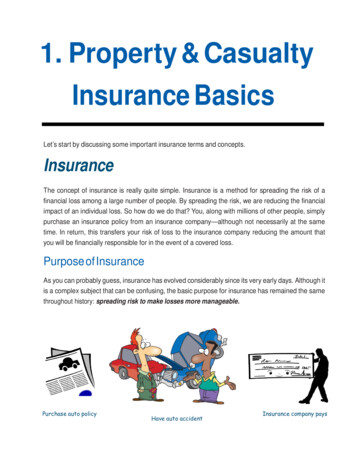
Transcription
1. Property & CasualtyInsurance BasicsLet’s start by discussing some important insurance terms and concepts.InsuranceThe concept of insurance is really quite simple. Insurance is a method for spreading the risk of afinancial loss among a large number of people. By spreading the risk, we are reducing the financialimpact of an individual loss. So how do we do that? You, along with millions of other people, simplypurchase an insurance policy from an insurance company—although not necessarily at the sametime. In return, this transfers your risk of loss to the insurance company reducing the amount thatyou will be financially responsible for in the event of a covered loss.Purpose of InsuranceAs you can probably guess, insurance has evolved considerably since its very early days. Although itis a complex subject that can be confusing, the basic purpose for insurance has remained the samethroughout history: spreading risk to make losses more manageable.Purchase auto policyHave auto accidentInsurance company pays
1 Property & Casualty Basics2Insurance Company (Insurer or Company)The insurance company is the entity that agrees to indemnify (make financially whole again) insuredsagainst covered losses. The insurance company writes the policy language and includes the rightsof the company within the guidelines of the insurance statutes (laws). Using actuaries, the companyestablishes rates to charge policyholders before making policies available for distribution.Lines of InsurancePropertyProperty Insurance includes various types of insurance designed to insure property from financialloss. The typical types of property items insured would be your house, auto, furniture, jewelry,business property or any type of physical property. The perils covered will depend on the typeof property contract that you purchase; however, the basic perils typically covered include fire,hail, windstorm, etc.The following types of insurance are generally considered to be property insurance:1. Dwelling2. Homeowners3. Commercial Property4. Inland Marine5. Ocean Marine6. CrimeThere are two parties involved with a property insurance contract: (1) the insured, and (2) theinsurance company. With property insurance, any insurance benefit payments by the insurancecompany will be paid directly to the insured or other specifically named interests.Casualty (Liability)Casualty insurance mainly protects you against legal liability for bodily injury (BI) and/or propertydamage (PD) you cause to other people. In other words, liability or casualty coverage will pay foraccidental damage you cause to another person or their property. There are three parties to aliability insurance contract— 1) the insured (you), 2) the insurer (insurance) company, and 3) theinjured party. 2014 0Chance2Fail.com. This PDF is made available for personal use only during your online course access time limits, subject to the 0Chance2Fail.com Terms of UseAgreement. Any other use requires prior written consent from the copyright owner. Unauthorized use, reproduction and/or distribution are strictly prohibited and violateapplicable laws. All rights reserved.
1 Property & Casualty Basics3Casualty Insurance includes various unrelated insurance products, such as:1. Aviation2. Auto3. Liability4. Workers Compensation5. Surety BondsPersonal Lines InsurancePersonal lines refer to property and casualty insurance for an individual as opposed to a business.Coverages would include homeowners, renters, auto, and personal umbrella to name a few. Thesepolicies include both property and casualty coverages. For example, coverage is available inauto policies to cover damage to your car (property) and accidental damage you cause to anotherperson's car (casualty or liability).Commercial Lines InsuranceCommercial lines refer to property and casualty insurance to cover a business as opposed topersonal lines, which cover personal risks. Examples include commercial general liability, workers'compensation, and commercial property insurance.Purchasing InsuranceSo How Does It Work?When you complete an insurance application, you will normallypay an initial amount of money with the application. In legaljargon, the money that you pay in exchange for insurancecoverage is called the consideration. In insurance jargon, it iscalled the premium. Actually, the statements that you makein the application along with payment of the initial premiumare part of the consideration. Of course, your statements mustbe truthful. 2014 0Chance2Fail.com. This PDF is made available for personal use only during your online course access time limits, subject to the 0Chance2Fail.com Terms of UseAgreement. Any other use requires prior written consent from the copyright owner. Unauthorized use, reproduction and/or distribution are strictly prohibited and violateapplicable laws. All rights reserved.
1 Property & Casualty Basics4The premium amount is set by the insurance company and is based on a number of factors relatedto what is being insured. In return for the premium, the insurance company agrees to pay for lossesaccording to the terms of the insurance policy.DeductibleWhile the agent is discussing coverage details with the applicant, various deductible amounts will bepresented to the applicant. As the deductible, the lower the premium will be.A deductible is the portion of a covered loss that is not paid by the insurance company. Therefore,the insured is responsible for any deductible amount at the time of loss. The insurance company willpay the remaining portion of any covered loss up to the policy limits.The insurance company is accomplishing two objectives by requiring a deductible:1. Deductibles help minimize frequent claims; and2. Deductibles help eliminate small claims.By having a 250, 500, or even a 1,000 deductible or higher, an insured will not usually report anyclaims up to the deductible amount.BinderAfter completing the application for insurance, the agent should issue a binder to the applicant. Abinder is an oral or written agreement that provides temporary evidence of insurance until apolicy can be issued. Note, that a binder does not guarantee that a policy will be issued. It onlyprovides temporary coverage while the application is underwritten at the home office. Nobinder can be valid beyond the issue date of the policy or beyond its effective date, whicheverperiod is shorter.Once completed, the agent will forward the application and any initial premium to the insurancecompany for underwriting. Insurance underwriting is the process of classification, rating, andselection of risks. In other words, it's the process of determining whether to accept a risk or not. If therisk is acceptable, the underwriters will determine the amount of coverage to issue and the premiumamount to charge.Who Are Insured’sIt's important to know who is insured under the policy.The person or entity that is listed first on the declarations page is referred to as the first namedinsured. The first named insured is the primary insured and holds the highest rank among all insuredsand has broader rights and obligations under the contract than any other insured. 2014 0Chance2Fail.com. This PDF is made available for personal use only during your online course access time limits, subject to the 0Chance2Fail.com Terms of UseAgreement. Any other use requires prior written consent from the copyright owner. Unauthorized use, reproduction and/or distribution are strictly prohibited and violateapplicable laws. All rights reserved.
1 Property & Casualty Basics5Examples of additional rights of the first named insured are the right to cancel the policy, the rightto initiate policy changes, and the receipt of any return premiums.Insurance TermsRiskRisk is defined as the possibility or chance of loss. It is not the actual loss. For example, whiledriving to work each day, you may have an automobile accident. Or, you might accidentally slip, fall,and injure yourself while running on your treadmill. It is uncertain if either of these accidents willactually occur—but the possibility (risk) does exist.Speculative Risk vs. Pure RiskThere are two types of risk: speculative and pure. Speculative risk offers the chance of loss aswell as the opportunity for gain. An example of a speculative risk is gambling. With gambling, youhave a choice to risk something for a possible gain.Before we continue, let me introduce you to an old friend, Joe Consumer. Joeenjoys playing cards a few times each week, wherever he can find a game. Joebets a small sum of money on each hand for the chance of winning or gaininga large sum of money. He may win or lose depending on the outcome of hispoker skills and hands he is dealt. This has the opportunity for a win or a loss a speculative risk. Keep in mind that speculative risks are not generallyinsurable.When was the last time you heard of an insurance company offering TexasHold'em coverage?Unlike speculative risks, pure risks only offer the possibility of loss. There is no opportunity for gainor profit with pure risks. For example, let's suppose Joe has a hot year playing cards and decides tobuy a new house. He walks into your insurance office decked out in a new Gucci navy pinstripe suitand sporting a dazzling Pave Diamond Dial Rolex Day Date Super President watch. Joe requestsa homeowner’s policy for his new house and some additional life insurance just in case he has astressful year playing cards and dies of a heart attack. The insurance on Joe's house and his life areconsidered pure risks. 2014 0Chance2Fail.com. This PDF is made available for personal use only during your online course access time limits, subject to the 0Chance2Fail.com Terms of UseAgreement. Any other use requires prior written consent from the copyright owner. Unauthorized use, reproduction and/or distribution are strictly prohibited and violateapplicable laws. All rights reserved.
1 Property & Casualty Basics6Characteristics (Elements) of Insurable RisksWhile insurance is the most common method to handle risk, not every risk can be insured. Insurerswill only insure pure risks, which are risks that have only the possibility of a loss. With a pure risk,there is not an opportunity to profit or gain from a loss.To be insurable, the risk must:1. Be a Predictable LossAn insurer must be capable of statistically predicting the possibility of theloss. As mentioned earlier, insurers require a large number of homogeneous(similar) risks to accurately calculate the frequency and the severity of losses,and to set their premiums accordingly. Insurers are able to measure risk andaccurately predict losses based on the law of large numbers.2. Be a Chance OccurrenceThe risk must be outside the insured’s control. The loss must be unexpected, accidental, or uncertain.Insurance cannot be provided for losses that are certain to occur. For example, the risk of loss dueto an automobile accident may be unexpected; however, the risk that the tires on your car willeventually wear out is not an unexpected loss, and therefore not insurable. Tires are expected towear out sooner or later.3. Not be CatastrophicInsurers typically will not insure risks that will expose them to losses thatmay occur to a large number of insureds at the same time. These causesof loss are not predictable; therefore, they are not insurable. Examplesare war, nuclear hazards, and flood.Remember, insurers must have a predictable limit to the losses theyinsure. Some insurers will cover catastrophic losses for a very highpremium; however, most high risk insurance is purchased throughexcess and surplus lines companies that we discuss later in this lesson. 2014 0Chance2Fail.com. This PDF is made available for personal use only during your online course access time limits, subject to the 0Chance2Fail.com Terms of UseAgreement. Any other use requires prior written consent from the copyright owner. Unauthorized use, reproduction and/or distribution are strictly prohibited and violateapplicable laws. All rights reserved.
1 Property & Casualty Basics74. Be Measurable and DefinitiveAn insurable risk is a loss that has a definite monetary value. The insurer must be able to measureor value a potential loss. Insurers will not simply insure a risk with an unknown value. Insurers mustknow the value or the limit they will have to pay if a loss occurs.For example, with home and auto coverage, the insurer must know the economic value of theproperty to be insured.5. Be AffordableThe loss must cause a financial or economic hardship to the insured or to the insured’s family. Lossesthat are too small to cause a financial hardship are not considered insurable.For example, if a tire on an auto runs over a sharp object and causes a blow-out, this loss by itselfwould not be an insurable risk. Replacing a single tire would not normally represent a large enoughfinancial risk to be insurable. However, if you accidently collided with another person's car causingbodily injury to the person and property damage to their car, this would be considered a financialhardship and, therefore, an insurable risk.ExposureExposure means almost the same as risk. An exposure can be defined as a condition or situationthat presents the possibility of a loss. For example, Joe takes a part-time job as a window washer forSkyscraper. He is exposing himself to the possibility of a long fall.LossLoss is the amount of financial damage to your property caused by perils for which you are insuredfor. Losses can be total or partial and are stated as a dollar amount.Direct LossSome property insurance policies cover only “direct” losses, some cover only “indirect” losses andsome cover both. This is a direct physical loss that occurs to your property by a covered peril suchas a fire damaging your home or an auto collision involving your covered auto. 2014 0Chance2Fail.com. This PDF is made available for personal use only during your online course access time limits, subject to the 0Cha
insurance company. With property insurance, any insurance benefit payments by the insurance company will be paid directly to the insured or other specifically named interests. Casualty (Liability) Casualty insurance mainly protects you against legal liability for bodily injury (BI) and/or property damage (PD) you cause to other people. In other words, liability or casualty coverage will pay forFile Size: 1MBPage Count: 28
